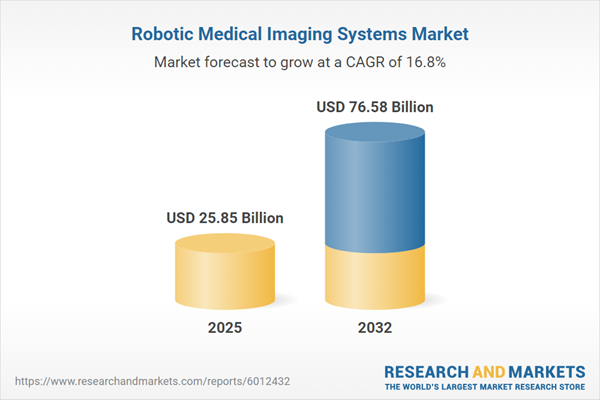Speak directly to the analyst to clarify any post sales queries you may have.
The robotic medical imaging systems market is experiencing a dynamic transformation, with advanced automation and artificial intelligence significantly elevating diagnostic capabilities and patient care across a rapidly evolving global landscape.
Market Snapshot: Robotic Medical Imaging Systems
The Robotic Medical Imaging Systems Market grew from USD 22.06 billion in 2024 to USD 25.85 billion in 2025. With a projected CAGR of 16.83%, it is expected to reach USD 76.58 billion by 2032. This sustained growth underscores the increasing adoption of robotics and AI-powered imaging in healthcare, as organizations worldwide seek new solutions to clinical precision, resource optimization, and operational efficiency.
Scope & Segmentation
- Product Types: Fixed systems (ceiling mounted, floor mounted), handheld systems (portable ultrasound probes, portable X-ray units), and mobile systems (C-Arm, wheeled platforms).
- Imaging Modalities: CT (cone-beam, multi-slice), MRI (closed, open), nuclear imaging, ultrasound (2D, 3D), X-Ray (analog, digital).
- End Users: Ambulatory surgical centers, diagnostic centers, hospitals, and research laboratories.
- Applications: Diagnostics (cardiology, oncology), interventional procedures (cardiovascular, neuro), patient positioning, and surgical assistance.
- Regions Covered: Americas (United States, Canada, Mexico, Brazil, Argentina, Chile, Colombia, Peru), Europe (United Kingdom, Germany, France, Russia, Italy, Spain, Netherlands, Sweden, Poland, Switzerland), Middle East (United Arab Emirates, Saudi Arabia, Qatar, Turkey, Israel), Africa (South Africa, Nigeria, Egypt, Kenya), Asia-Pacific (China, India, Japan, Australia, South Korea, Indonesia, Thailand, Malaysia, Singapore, Taiwan).
- Leading Companies: Siemens Healthineers AG, GE HealthCare Technologies Inc., Koninklijke Philips N.V., Canon Medical Systems Corporation, Medtronic plc, Intuitive Surgical, Inc., Stryker Corporation, Zimmer Biomet Holdings, Inc., Accuray Incorporated, Brainlab AG, AdEchoTech, General Electric Co., Hitachi Ltd., MGI Tech Co. Ltd., Medirob AB.
Key Takeaways for Senior Decision-Makers
- Robotic medical imaging systems are reshaping traditional diagnostic workflows by integrating automation, AI, and real-time optimization to achieve consistent results and reduce procedural variability.
- The convergence of robotics and machine learning enhances diagnostic reliability and tailors imaging to patient-specific needs, supporting the movement toward personalized and value-based care models.
- Emerging global adoption patterns reveal that healthcare providers in developed and emerging markets are prioritizing modular, portable, and interoperable imaging technology to address infrastructure disparities and rising imaging volumes.
- Regulatory agencies now emphasize risk-based frameworks for software as a medical device, enabling more rapid market access for AI-augmented imaging tools while demanding stringent validation and robust compliance evidence.
- Collaborative innovation between device manufacturers, technology partners, and clinical institutions is accelerating the release of advanced platforms, while also driving industry efforts in supply resilience, cybersecurity, and continuous product improvement.
Tariff Impact: United States Policies in 2025
Recent US tariffs have affected global supply chains by raising costs for critical components used in robotic imaging platforms, prompting manufacturers to adapt by relocating subassembly processes and investing in localized production hubs. These shifts are influencing pricing models and procurement planning for healthcare providers, while simultaneously encouraging stronger alliances with domestic suppliers for long-term supply chain stability.
Methodology & Data Sources
This report utilizes a hybrid research approach, combining primary interviews with decision-makers and secondary analysis of peer-reviewed publications, regulatory filings, and proprietary databases. Extensive data triangulation and scenario validation ensure that insights are reliable and actionable for senior leaders in the industry.
Why This Report Matters
- Enables informed capital allocation and strategic planning with comprehensive evaluation of innovation, adoption drivers, and clinical impact in robotic medical imaging systems.
- Equips executives to anticipate supply chain risks, regulatory shifts, and evolving competitive landscapes worldwide.
- Supports identification of high-growth segments, technology trends, and partnership opportunities to guide long-term market positioning.
Conclusion
Robotic medical imaging systems are redefining global healthcare delivery through automation, AI, and collaborative innovation. Senior decision-makers can leverage this report's insights to navigate complexity and capture emerging opportunities in a rapidly evolving market.
Additional Product Information:
- Purchase of this report includes 1 year online access with quarterly updates.
- This report can be updated on request. Please contact our Customer Experience team using the Ask a Question widget on our website.
Table of Contents
3. Executive Summary
4. Market Overview
7. Cumulative Impact of Artificial Intelligence 2025
Companies Mentioned
The companies profiled in this Robotic Medical Imaging Systems market report include:- Siemens Healthineers AG
- GE HealthCare Technologies Inc.
- Koninklijke Philips N.V.
- Canon Medical Systems Corporation
- Medtronic plc
- Intuitive Surgical, Inc.
- Stryker Corporation
- Zimmer Biomet Holdings, Inc.
- Accuray Incorporated
- Brainlab AG
- AdEchoTech
- General Electric Co.
- Hitachi Ltd.
- MGI Tech Co. Ltd.
- Medirob AB
Table Information
| Report Attribute | Details |
|---|---|
| No. of Pages | 195 |
| Published | October 2025 |
| Forecast Period | 2025 - 2032 |
| Estimated Market Value ( USD | $ 25.85 Billion |
| Forecasted Market Value ( USD | $ 76.58 Billion |
| Compound Annual Growth Rate | 16.8% |
| Regions Covered | Global |
| No. of Companies Mentioned | 16 |









